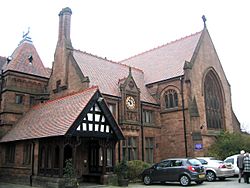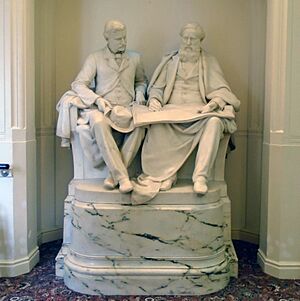Turner Home, Liverpool facts for kids
Quick facts for kids Turner Home |
|
|---|---|

Entrance porch and chapel
|
|
| Location | Dingle Lane, Toxteth, Liverpool, Merseyside, England |
| OS grid reference | SJ 364 875 |
| Built | 1884 |
| Built for | Mrs Anne Turner |
| Architect | Alfred Waterhouse |
| Architectural style(s) | Gothic Revival |
|
Listed Building – Grade II
|
|
| Designated | 14 March 1975 |
| Reference no. | 1068252 |
| Lua error in Module:Location_map at line 420: attempt to index field 'wikibase' (a nil value). | |
The Turner Home is a special place in Toxteth, Liverpool, England. It used to be called the Turner Memorial Home. This home was built to help men who were sick or needed support. Today, it still works as a home for men who need care. The building itself is very important. It is listed as a Grade II building on the National Heritage List for England. This means it's a historic building that needs to be protected.
History of the Turner Home
The Turner Home was finished in 1884. A famous architect named Alfred Waterhouse designed it. Mrs. Anne Turner had it built to remember her husband and son. They had both passed away. Her husband, Charles Turner, was a successful merchant from Liverpool. He was also a Member of Parliament. Charles Turner died in 1875, and his son died five years later.
The home was first called "The Turner Memorial Home of Rest for Chronic Sufferers." Over time, the building started to get old. In 1984, people started a special fundraising effort. They wanted to collect money for important repairs. As rules for nursing homes changed, the home added more modern rooms.
In 1993, the Eric Fischer Wing was built. It has 44 bedrooms, each with its own bathroom. Then, in 2000, the Ian Tod Wing was added. This new part included a special area for recovery and more bedrooms. The Turner Home can now offer both residential and nursing care.
Besides medical care, the home provides other services. These include foot care, dental care, and eye doctor visits. Residents can also get their hair done. Parts of the main building are used for fun activities. People can eat meals together or play games like pool. Religious services are held twice a week in the chapel. The home also plans holidays and trips for the residents. A group called the League of Friends helps support the home's work.
Architecture and Design
The Turner Home is built from red sandstone with a tiled roof. Its style is called Gothic Revival. This means it looks like older Gothic buildings. The building has a very unusual shape. Most of it has two floors, plus extra rooms in the roof space.
You enter the home through a wooden porch. To the right of the entrance, there is a section with a clock from 1883. Further right is a chapel with five sections. The chapel has a large window with special stone patterns. It also has three-light windows along its sides. To the left of the entrance, there is a round tower with a pointed roof.
The windows in the main building have stone frames. They also have vertical and horizontal bars. The doorways are shaped like pointed arches. The chimneys are tall and grouped together.
Inside the entrance hall, there is a large marble statue. It shows Charles Turner and his son sitting down. They are looking at a piece of cloth. Anne Turner asked a sculptor named Hamo Thornycroft to create it in 1885.
The chapel inside the home has an open wooden roof. There is also a balcony where the organ is located. An aisle runs along the side of the chapel. It has arches supported by eight-sided columns. Behind the altar, there is a carved alabaster screen. The stained glass in the window above the altar was made by Heaton, Butler and Bayne. Next to the windows, there are boards with the Ten Commandments, the Creed, and the Lord's Prayer.
The Lodge Building
At the start of the driveway leading to the home, there is a small building called a lodge. It was also built in 1884 and designed by Alfred Waterhouse. The lodge is made of stone with a tiled roof. It has an L-shaped design. This lodge is also a Grade II listed building, just like the main home.


